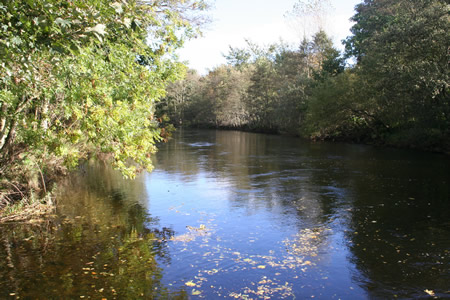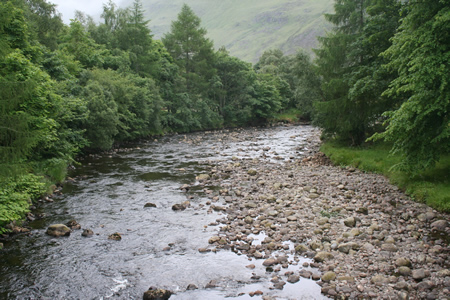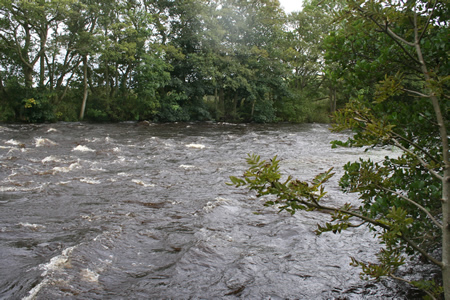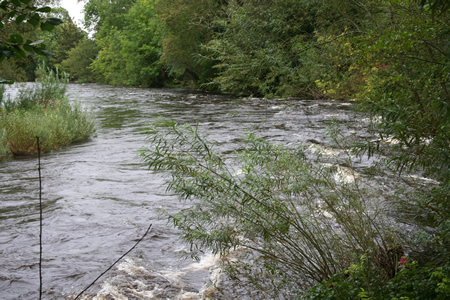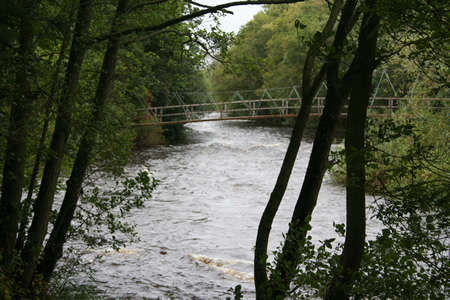These bulletin blogs represent news about Finavon and the South Esk, and my views as a riparian owner. They are not the views of any other organisation, nor are they designed to promote the interests of any individual or organisation other than Finavon Castle Water and factors affecting the fishery. Tony Andrews
After heavy rain last Friday the river came up quickly and flooded the woods at Indies and Bogardo, no doubt spreading more Himalayan balsam seeds in the process. A tricky few days followed with high and turgid water, but a lot of fish, both salmon and sea trout, showing in all the pools but only one caught each day. Our visiting rods saw action, with fish pulling but not hooking, and a few salmon lost.
This photo is of the lower section of Melgund Pool, which has some well placed lie boulders in the tail and about 30 yards above. It looks perfect for holding salmon in high or medium water. Apart from one pile of boulders, it offers a reasonably easy wade. I recommend this part of the highly productive Melgund Pool for an autumn salmon. Melgund is in fact quite a long pool, of similar dimensions to House Pool, and just as likely a pool to catch salmon and sea trout.
I fished Marcus House Pool late in the afternoon on Tuesday, but the water was too high and fast for a pool that is at its best in a medium river height. Later on I fished down Frank’s Stream, which again was pretty big, and caught a lovely silver 9lbs salmon at the head of the pool. I also caught a lively four pound sea trout in the tail of Indies Pool, which at that water height is a pool of genuine scale, inviting you to open your shoulders and cast a long line right across the fan-shaped tail towards the jumble of accumulated flotsam at the top of Merrinwood. There were quite a few salmon showing in the run just above the right bank overhanging willow that marks the main boulder feature and holding spot of Indies Pool.
This photo is of the main stem of the South Esk just below Braedownie in Glen Clova. This section of the River provides spawning and excellent juvenile habitat for salmon and sea trout. People who fish the middle river of the South Esk often forget how many miles of river there is above the confluence of the S Esk and Prosen, just downstream of Cortachy Castle. Salmon are caught by Kirriemuir Angling Club members and anglers from the Glen Clova Hotel. The meandering and silty river in the flood plain of the glen provides good holding water for salmon throughout the summer and autumn.
Overnight on Tuesday the river dropped quietly to a much more manageable level and the water cleared. Fishing at 0700 on Milton Beat I saw a number of fish, especially in Willows, but, as in the previous two days, the fishing was dour and I moved nothing. However, late in the afternoon I had a report from Moray that he had landed a pristine 12lb fish in that magic place in the Red Brae that I described in the last bulletin. An hour later I caught another of exactly the same size in Frank’s Stream just below the willow groyne, a beautiful deep & sea-liced autumn salmon: bright silver and firm fleshed.
If the river continues to drop slowly, and the occasional shower provides freshets to keep the chemical signals bringing in more fresh salmon, the fishing should improve considerably during the rest of the week. The totals for Finavon Castle Water for the 2011 season are 114 salmon and 95 sea trout, which, if October comes up to its normal productivity, should see us with over 150 salmon for the season, and perhaps just over 100 sea trout.
The beats are now fully booked for the rest of the 2011 season.
TA
